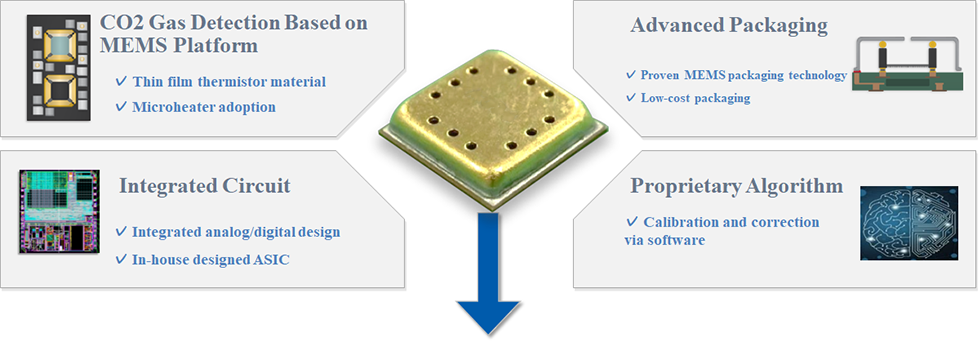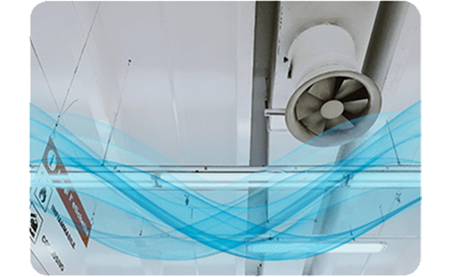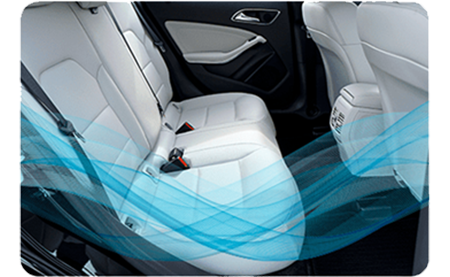Compact and low power consumption CO₂ gas sensor (Under Development)

Contents
Rising Demand for CO₂ Sensing
Have you ever experienced a decline in concentration or felt drowsy after spending a long time in a room with insufficient ventilation? The cause might be attributed to CO₂. When the concentrated level of CO₂ in a room rises, it can affect the human body in various ways, such as causing headaches, drowsiness, and fatigue. Consequently, a concentrated level of CO₂ is employed as an indicator for evaluating air pollution. According to research conducted by institutions such as the State University of New York, cognitive function reportedly decreases by 20% for every 400ppm increase in indoor CO₂ concentration. If we take the score at 500ppm as a baseline, performance in decision-making significantly diminishes as the level rises to 2,500ppm. Recently, in efforts to contain the spread of the novel coronavirus, the adoption of CO₂ concentration as a guideline for ventilation in spaces has been increasing. Moreover, the need for devices that detect the amount of CO₂ emitted from factories, industrial equipment, and vehicles is also growing as part of global warming countermeasures. Thus, from daily health to global issues, CO₂ sensing is becoming increasingly vital.
Source:
U.Satish, et.al. : Is CO₂ an Indoor Pollutant? Direct Effects of Low-to-Moderate CO₂ Concentrations on Human Decision-Making Performance, Environmental Health Perspective 120, 1671(2012)
Previous Challenges in CO₂ Sensing
Despite the growing need for measuring air-borne chemicals, including CO₂, previous CO₂ sensors have encountered numerous technical challenges. Conventional sensors typically measure the quantity of molecules present in a gas optically, which not only necessitates larger sensor packaging but also results in higher power consumption and cost, limiting the devices in which they can be installed. Moreover, sensors measuring eCO₂ *1, while benefiting from smaller size and lower power consumption, measure the amount of substances equivalent to CO₂ instead of directly measuring CO₂ in the air, presenting a challenge due to their lower detection accuracy.
*1 eCO₂: Equivalent carbon dioxide.
Current Challenges in CO₂ Sensing
- Optical Sensors:Large size, high power consumption, expensive
- eCO₂-Based Sensors:Not highly accurate in measuring CO₂
Features and Advantages of TDK's CO₂ Gas Sensor
The core technology of the CO₂ gas sensor is a sensor chip using new material development and MEMS*2 process technology, a control circuit (ASIC) adopting a hybrid design of onboard microcontroller and analog, a package using TDK's MEMS microphone technology and processes, and software equipped with unique calibration and correction functions. These technologies enable the detection of CO₂ gas (400-5,000 ppm), and realize a compact and slim design (5.0 × 5.0 × 1.2 mm), as well as low power consumption (1.8mW / 60-second measurement cycle).
*2 MEMS: Micro Electro Mechanical Systems. These devices integrate electrical circuits and mechanical component elements, achieving miniaturization and low power consumption of products.
| ✓Direct CO₂ detection | 400-5,000 ppm |
| ✓Compact and low profile | 5.0 x 5.0 x 1.2 mm |
| ✓Low power consumption | 1.8 mW (60 sec. measurement cycle) |
Potential Applications of Compact CO₂ Gas Sensors
TDK's CO₂ sensor, which is smaller and consumes less power than conventional CO₂ gas sensors, various applications in devices, where installation was not previously possible, are now feasible.
TDK's CO₂ sensor, which is smaller and more energy-efficient than traditional CO₂ gas sensors, enables various applications in devices that were previously unsuitable for installation. Examples of these applications include a mobile air quality monitor that allows easy measurement of the air environment in rooms, and a vehicle air environment monitor to support safe driving during long-distance trips. Furthermore, in smart buildings and smart homes, CO₂ gas sensors can be usesd for systems control heating, ventilation, and air conditioning (HVAC) equipment according to CO₂ concentration. Future developments into wearable devices are anticipated. Systems that control air conditioning according to temperature and humidity have now become commonplace. Moving forward, as various gas sensors, including those for CO₂, continue to evolve, more advanced air environment monitoring will become possible, which is expected to further contribute to maintaining the health of many individuals.
Indoor Air Quality (IAQ) Monitoring
Demand-Controlled Ventilation (DCV) Systems
In-Vehicle Air Quality Monitoring
Wearable Devices
Summary
TDK's CO₂ gas sensor is a product that is much smaller in size and achieves low power consumption. TDK is developing CO2 gas sensor by harnessing various technologies, including a MEMS structure sensor element using TDK's thin-film thermistor, an ASIC to control the sensor, a package compatible with MEMS structures, and software technology. We believe that TDK's CO₂ gas sensor can be applied to various devices where installation has not been possible before. TDK will continue to work on various application developments of gas sensor technology, including CO₂ sensors. If you have a project in which the products and technologies described in this article can be helpful, please feel free to contact us.






